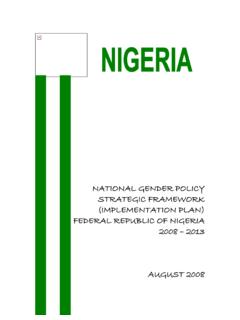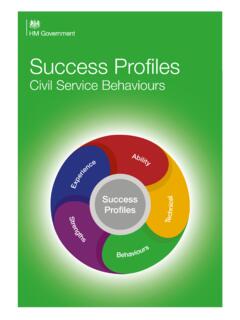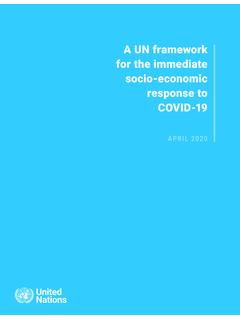Transcription of The Business Case for Equality and Diversity - GOV.UK
1 BIS OCCASIONAL PAPER NO. 4 THE Business CASE FOR Equality AND Diversity A survey of the academic literature JANUARY 2013 The Business Case for Equality and Diversity : a survey of the academic literature The Views expressed within BIS Economics Papers are those of the authors and should not be treated as Government policy The Business Case for Equality and Diversity : a survey of the academic literature Contents List of tables and Foreword ..v Executive Summary ..vi Introduction ..1 Scope and aim of research ..1 Methodology ..1 The Business case and the moral case ..2 Conclusions ..5 A framework for the Types of Diversity ..6 Reported Business Benefits of Equality and Can we Separate Equality from Diversity Business Benefits?
2 8 Building the Evidence on the Business case ..15 Evidence on Workplace Diversity ..15 Evidence on Workplace Equality Evidence on Diversity in team and group Remaining branches of the literature and important terminology ..25 Bringing together the findings: the importance of context ..27 strategic Approaches ..30 strategic approaches to Equality and Diversity ..30 Viewing Diversity as strategic Capability ..34 i The Business Case for Equality and Diversity : a survey of the academic literature ii Implications ..35 Firms ..35 Policymakers ..36 Appendix ..39 Method ..39 Review questions ..39 Scope of review and key search Search methodology ..41 Outcomes in Brief.
3 41 Practitioner sources: 48 articles ..41 Academic journals: 64 Metrics of Diversity and Business Outcomes ..42 Bibliography ..44 BIS Economics Papers ..53 The Business Case for Equality and Diversity : a survey of the academic literature List of tables and figures Figures Figure 1: A framework for External and Internal Diversity Business 11 Tables Table 1: Categories and types of 6 iii The Business Case for Equality and Diversity : a survey of the academic literature Acknowledgements The Westminster Business School team (Professor Peter Urwin, Emma Parry, Ian Dodds, Valeriya Karuk and Alan David) are grateful for the advice and help of the project board (Paul Crawford, and Helen Carrier and Giovanni Razzu from GEO), the practitioners who took part in the workshops, and the BIS Central Equalities Team (in particular Janis Makarewich-Hall).
4 Iv The Business Case for Equality and Diversity : a survey of the academic literature Foreword In difficult and challenging economic times, using the talents of the whole workforce is more important than ever. Considering the Diversity of your workforce and fostering an inclusive working environment can bring Business benefits and provide a market advantage in economically straightened times. This tough climate has led us to take a fresh look at the evidence helps us understand how Diversity usefully feeds into evidence based policy-making and has positive impacts for businesses. A real strength of the UK is our labour market flexibility and making the most of everyone s skills, working patterns and potential is vital for success.
5 The UK is considered to be one of the most diverse nations in the world. Respecting that Diversity and being inclusive gives firms the widest possible pool of talent and competitive advantages. This research is ambitious as it has taken a comprehensive review of the key economic evidence that underpins the Business benefits of Equality , Diversity and inclusion. The academic evidence only tells a part of the story. This is why we are developing in-depth case-studies which could demonstrate where businesses have reaped real benefits and why. This kind of evidence will make it more real to a wide range of businesses large and small, domestic and international and in a variety of sectors.
6 We need to move away from Diversity being a human resources issue to realising that companies can prosper by making the most of the Diversity and flexibility of their workforce and customers. JO SWINSON Minister for Employment Relations and Consumer Affairs and Minister for Women and Equalities v The Business Case for Equality and Diversity : a survey of the academic literature Executive Summary Understanding the Business impacts of Equality and Diversity : what does the evidence tell us? This report considers the evidence for the Business case for Equality and Diversity in private sector organisations. The aim is not to make the Business case, but to assess the current evidence from academic journals and some key practitioner sources.
7 Key findings Studies appear to have found evidence that firms have reaped Business benefits from Equality & Diversity , but not all firms in all contexts at all times. The firm s economic and organisational context is crucial in determining how Equality and Diversity brings about Business benefits. The Business case is likely to depend on the markets a firm operates in, its labour market, organisational and other strategies and the actions of managers and leaders. How Diversity is managed is also crucial: if appropriately, it can bring benefits to Business , if poorly, it can increase costs. Different approaches are likely to be needed, depending on the nature of Diversity , the internal workplace context and external environment.
8 There is no single approach that all businesses can adopt to ensure Equality and Diversity are beneficial. To be effective, Equality and Diversity need to be embedded in the Business strategy, not treated as an ad-hoc addition. Key policy implications There is no one-size-fits all solution . Businesses know best their own market and sector, and should approach Equality and Diversity with that in mind. Government needs to take this into account in its engagement with Business on this issue. This is not saying that businesses can ignore Equality and Diversity if it is not in their Business interests (they still have to comply with the law), but rather that they may be overlooking important Business benefits.
9 Gestures cost money: to achieve benefits and avoid costs, businesses need to see Diversity as a strategic resource. Being strategic about Equality and Diversity means more than merely complying with legislation, although this too can result in Business benefits. vi The Business Case for Equality and Diversity : a survey of the academic literature Approach This research was commissioned by the Department for Business Innovation & Skills (BIS) and the Government Equalities Office (GEO). This report sets out the findings from a systematic review of the (primarily academic) literature on the evidence for the Business case for Equality and Diversity .
10 The Business case is distinct from the legal and moral case in that it involves factors which can improve the economic performance and competitiveness of the firm. The focus is on evidence that is relevant for businesses seeking market advantage in a competitive environment. The report aims to: improve understanding of theoretical positions and issues related to the Business case for Diversity and Equality develop a consistent framework for assessing evidence on the Business case within this framework , present a review of the evidence create a robust compendium of the evidence. These are needed to assess a fragmented literature where different conceptual frameworks, methods, and measures have been used, and where there are substantial methodological challenges.













